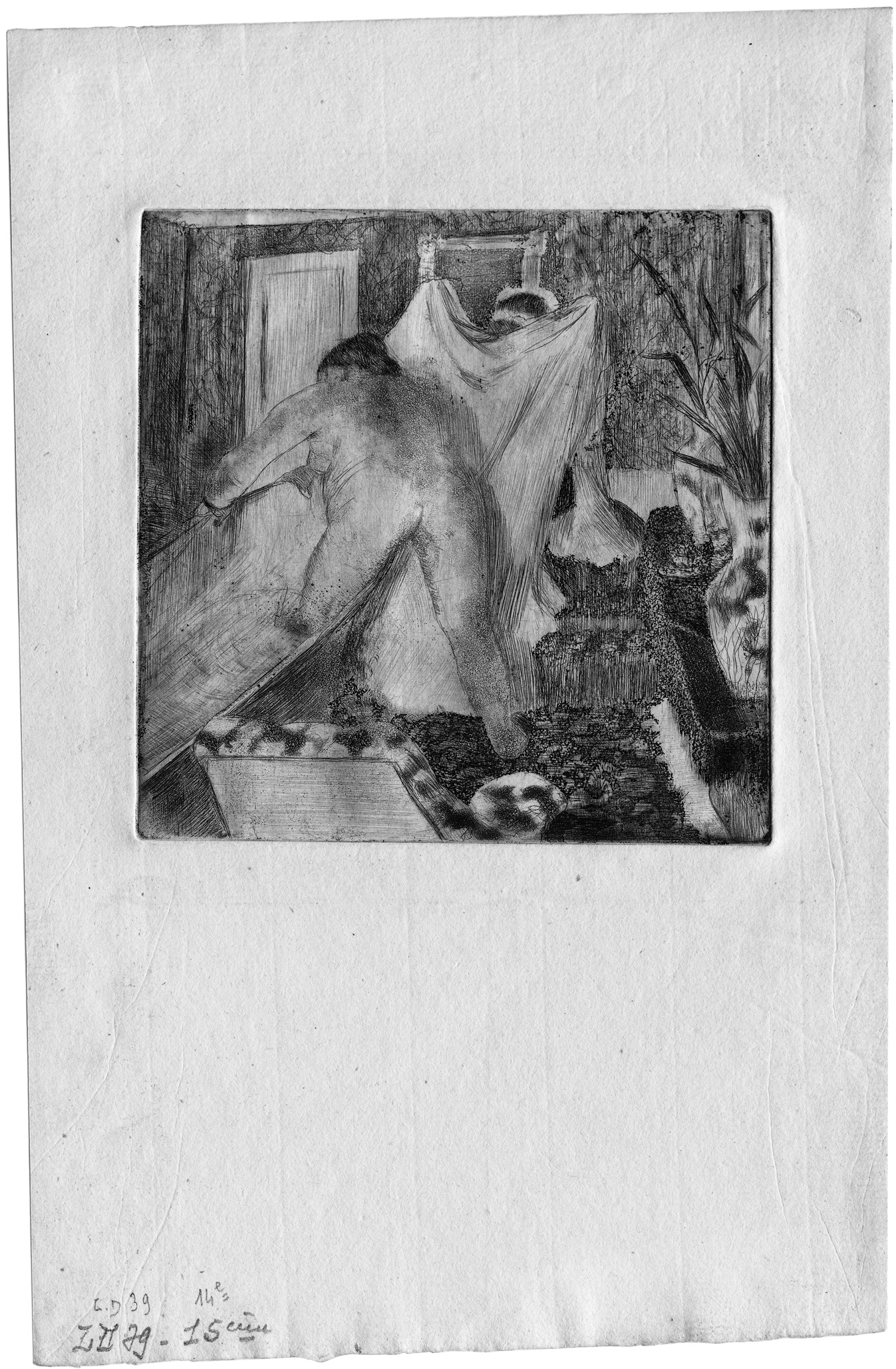Loading the page ...
Edgar Hilaire Germain Degas
(1834–1917, Paris)
La sortie du bain. Etching, drypoint and aquatint on cream-coloured wove paper with partially visible watermark “Freres”. 12.7 x 12.7 cm. Circa 1879–80. Delteil 39 XV (of XVII); Adhémar 49; Reed and Shapiro 42 XX (of XXII). With the red Degas Atelier stamp (Lugt 657) at the upper left verso.
Edgar Degas is indisputably one of the greatest printmakers of all time. Few of his contemporaries can have been driven by such a desire for perfection and such an unrelenting self-imposed severity as this brilliant artist and melancholy loner. Degas’ almost self-tormenting approach and his uncontrollable urge to constantly check the validity of his artistic solutions are particularly evident in his printed work. The large number of different impressions testifies to a highly concentrated method of working characterized by self-doubt, constant corrections and immense creativity.
La sortie du bain unquestionably provides very impressive evidence of this. On no other etching did Degas work so intensively and purposefully, as can be seen from the number of different states, numbering twenty-two in all, a fact that gives this work a unique status in the artist’s entire printed oeuvre (see illustration). Each individual state often displays only minimal changes, additions and new artistic means of expression for the rendering of light, atmosphere and textures.
The story goes that Degas began the etching at the home of his
friend, Alexis Rouart, after slippery ice had prevented him from going straight home. The etching was done around 1879/80 during a phase in which the artist was experimenting intensively with innovative printing techniques. In the very first state Degas clearly defined the basic elements of the composition, and the
following twelve states merely show subtle shifts of emphasis, which nevertheless bring about surprising changes in the overall picture. While, for example, the seventh state of the etching has a rather austere appearance, having been reduced to clear black-and-white contrasts, the artist achieves increasingly refined graphic formulas in the states that follow. Degas’ etching needle creates a dense, patchwork-like pattern of individual hatchings and highly decorative, filigree surface structures that generate a warm, vibrant light effect. The graphic appearance of the wallpaper, the armchair and the bathtub in the foreground as well as the boldly foreshortened perspective of the fireplace show metamorphoses testifying to the tireless creative determination of the artist. In the fourteenth state the body of the bathing woman has been given a fine aquatint grain, which makes her contours appear soft and hazy, creating a convincing suggestion of warm, pulsating physicality. Interestingly enough, in the last state Degas removed the aquatint tone from her body, thus restoring the original appearance of the earliest states. By this time, however, the copperplate was so worn that it was impossible to print more impressions. The etching is very rare despite the large number of states. Only single impressions were printed from each state, so that the entire edition came to just a few dozen impressions, most of which are in museum collections (see exhibition catalogue Degas, Paris-Ottawa-New York 1988/89, p. 305ff).
However it is not only these technical refinements that make La sortie du bain such an exquisite work of art. The most striking features are the absolute originality of Degas’ artistic vision and his unique talent for pointed characterization. Minimum space has been used to create maximum atmosphere, fluctuating light and physical sensuousness. Degas’ razor-sharp powers of observation enable him to portray the ungainly, somewhat shapeless body of the woman as she heaves herself awkwardly out of the bathtub. The muted light adds to the intimacy of the scene. A servant girl holds up a soft dressing gown, and the artist observes good-humouredly how her pert little face peeps out over the top of it. The decorative textile patterns, the flower vases on the mantelpiece and the comfortable armchair radiate domestic cosiness and create an atmosphere of feminine familiarity.
A very fine, sparkling impression with very distinct tonal gradations, printed on the full sheet. Minor ageing, an unobtrusive horizontal printer’s crease in the lower margin, and unobtrusive remains of adhesive tape on the reverse; otherwise in mint, untouched condition.
Contact us for further information